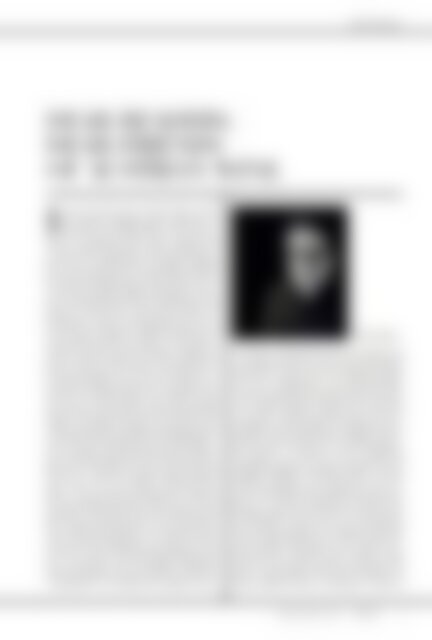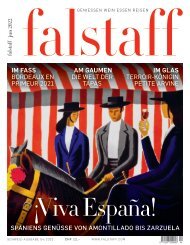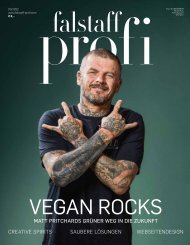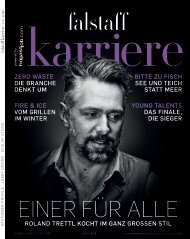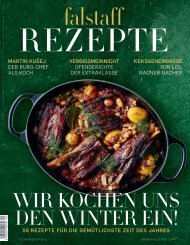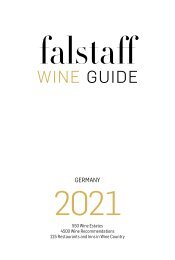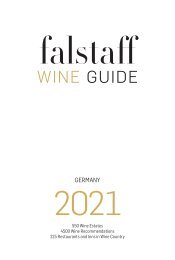Create successful ePaper yourself
Turn your PDF publications into a flip-book with our unique Google optimized e-Paper software.
EDITORIAL<br />
<br />
DEAR READERS,<br />
DEAR FRIENDS<br />
OF AUSTRIAN WINE<br />
Peter Moser<br />
It was 16 years ago now that I first wrote<br />
this English language guide dedicated to<br />
Austrian wine and producers who concentrate<br />
on exporting their wines outside the<br />
country. These passionate vintners fulfil important<br />
roles as ambassadors of quality making<br />
the wines produced in our little Alpine Republic<br />
known throughout the world. Grape varieties<br />
such as Grüner Veltliner, Riesling, St. Laurent<br />
and Blaufränkisch have championed the<br />
hearts of wine lovers around the world. Although<br />
the volume of wine produced in Austria<br />
is barely enough to fulfil the demands of<br />
the domestic market, the share of wine exportations<br />
continues to grow. Despite a slight decline<br />
in export volume due to the small 2016<br />
harvest, the export year 2017 exceeded all expectations.<br />
With a steep increase in export values,<br />
the 150-million mark was cracked for the<br />
first time at 158.6 million euros. The average<br />
price per litre achieved a new all-time high. The<br />
former “Grosslage” Rosalia, just south of the<br />
Leitha Mountains in the heart of Burgenland is<br />
now Austria’s eleventh DAC protected designation<br />
of origin. Typical regional wines will appear<br />
under “Rosalia DAC” and “Rosalia DAC<br />
Reserve” in the future, while unique regional<br />
rosé wines will be labelled “Rosalia DAC<br />
Rosé”. A new quality pyramid for Austrian<br />
Sekt (sparkling wine with a minimum of 3 bars<br />
pressure in the bottle) has been created with<br />
three levels: Klassik, Reserve and Große Reserve.<br />
With the purchase of an Austrian Sekt<br />
with protected designation of origin, one has<br />
not only a wine of documented pedigree, but<br />
also a guarantee that the highest standards<br />
have been observed in its production. The term<br />
“sustainable” is no longer just a slogan in Austria<br />
and it is pleasing that Austrian vintners are<br />
so ambitious when it comes to environmental<br />
protection in their choice of production methods.<br />
Our winegrowers are environmentally<br />
conscious and demonstrate this in the way they<br />
care for their greatest capital, their vineyards.<br />
As of 2015 Austrian vintners now have the<br />
possibility to abtain official verification for sustainable<br />
vineyard cultivation methods and label<br />
their wines with the seal “certified sustainable<br />
Austria”. A trend in “new” vinification<br />
techniques witnesses vintners returning to old<br />
methods. Whether Sauvignon Blanc, Grüner<br />
Veltliner, Riesling, or St. Laurent one can observe<br />
experiments with vini fication in clay amphora,<br />
an ancient production method from<br />
Georgia where “Kvevri” have been used since<br />
the Neolithic period. There are experimental<br />
wines being produced in multiple variations<br />
with minimal intervention, even without sulphur<br />
dioxide. “Natural” and “orange” wines<br />
remain rare, but their number is growing. And<br />
that is a good thing. New taste variations are<br />
being explored and an alternative world of<br />
WINE GUIDE <strong>2018</strong><br />
falstaff<br />
5


